Benefits of Yoga during Pregnancy
It has been said that yoga can be very beneficial during pregnancy. Not only does it help you stay fit, it also helps improve your energy level and allows you to become more in tune or intimate with your body. Yoga can be a great way to stay flexible and prepare for birth. Yoga exercises, through a series of gentle stretches, help tone the reproductive organs, pelvis and the rest of your body to ensure an easier childbirth. Posture is also improved by yoga and this can help ease back problems, which are common in pregnant women.However, as with any exercise program, it is best to consult your physician before beginning.
Why do Yoga during Pregnancy
Increases overall strength, flexibility & well-being — When you practice yoga, you are not only stretching your muscles, but you are stretching the tissues that encase your muscles, stimulating your organ systems, promoting the circulation of blood and oxygen, breathing more intentionally, and focusing your attention inward through imagery and meditation.Reduces low back pain & sciatica — As you are taught to become acutely aware of proper body alignment, you can carry yourself and your belly in an integrated manner. This can help to reduce the degree of pelvic tilt associated with pregnancy and significantly reduce the lower back pain which it can cause.
Reduces aches & fatigue in the thoracic & cervical regions of the spine —During pregnancy, it can be difficult to find a space for yourself when trying to sleep at night. As a result, spinal alignment can become compromised during the night. This can leave congestion and muscle tension in the middle and upper regions of spine. Yoga not only creates more fluidity in the spine by stretching the Para spinal muscles, but also involves very gentle rotation of the upper torso. When these sequences are combined with directed yoga breathing, it can have the effect of relieving stress and creating more breathing room in these regions of the spine.
Reduces swelling & inflammation around your joints — A regular and consistent asana practice improves and promotes the circulation of blood and oxygen throughout your body. This in turn, can reduce swelling and inflammation around ankles and wrists.
Aids in digestion — As baby grows, your intestinal organs get pushed around which may affect your regularity and cause indigestion. A regular practice of safe and gentle rotations and forward folds can help to promote regularity and aid in overall digestive flow.
Helps prepare you physically for giving birth — A regular practice of squatting asana helps to tone muscles of your pelvic floor and to help you gain strength to remain comfortable in a squatting position. You will want to be able to use these muscles efficiently and effectively when nature calls upon you to push your baby into the world.
Improves your emotional well-being — Participating in a prenatal class provides a community of support from people who understand what you are experiencing. It is a place to make new friends with whom you feel similarly situated. The combination of the physical or asana portion of yoga with the emotional and spiritual component can be an aid in reducing pregnancy-related anxiety and helping to experience the miracle and empowerment of pregnancy.
9 Yoga Poses
These poses can help you in dealing with the symptoms of pregnancy, ensuring smoother and easier delivery, and faster recovery after childbirth. Poses that put pressure on the abdomen and other difficult poses should not be done during advance stages of pregnancy.Quadruped arm/leg raise: Get down on your hands and knees. Tighten your abdominal muscles to stiffen your spine. While keeping your abdominals tight, raise one arm and the opposite leg away from you. Hold this position for 5 seconds. Lower your arm and leg slowly and alternate sides. Do this 10 times on each side.
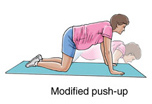
Lunge: Stand and take a large step forward with your right leg. Dip your left knee down toward the floor and bend your right leg. Return to the starting position. Repeat the exercise, this time stepping forward with the left leg and dipping the leg on your right side down. Do 3 sets of 10 on each side.
 Wall squat: Stand with your back, shoulders, and head against a wall and look straight ahead. Keep your shoulders relaxed and your feet 1 foot away from the wall and a shoulder's width apart. Keeping your head against the wall, slide down the wall, lowering your buttocks toward the floor until your thighs are almost parallel to the floor. Hold this position for 10 seconds. Make sure to tighten the thigh muscles as you slowly slide back up to the starting position. Do 3 sets of 10. Increasing the amount of time you are in the lowered position helps strengthen your quadriceps muscles.
Wall squat: Stand with your back, shoulders, and head against a wall and look straight ahead. Keep your shoulders relaxed and your feet 1 foot away from the wall and a shoulder's width apart. Keeping your head against the wall, slide down the wall, lowering your buttocks toward the floor until your thighs are almost parallel to the floor. Hold this position for 10 seconds. Make sure to tighten the thigh muscles as you slowly slide back up to the starting position. Do 3 sets of 10. Increasing the amount of time you are in the lowered position helps strengthen your quadriceps muscles.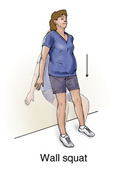 Heel raise: Balance yourself while standing behind a chair or counter. Using the chair to help you, raise your body up onto your toes and hold for 5 seconds. Then slowly lower yourself down without holding onto the chair. Hold onto the chair or counter if you need to. When this exercise becomes less painful, try lowering on one leg only. Repeat 10 times. Do 3 sets of 10.
Heel raise: Balance yourself while standing behind a chair or counter. Using the chair to help you, raise your body up onto your toes and hold for 5 seconds. Then slowly lower yourself down without holding onto the chair. Hold onto the chair or counter if you need to. When this exercise becomes less painful, try lowering on one leg only. Repeat 10 times. Do 3 sets of 10.
Rowing exercise: Tie a piece of elastic tubing around an immovable object and grasp the ends in each hand. Keep your forearms vertical and your elbows at shoulder level and bent to 90 degrees. Pull backward on the band and squeeze your shoulder blades together. Repeat 10 times. Do 3 sets.
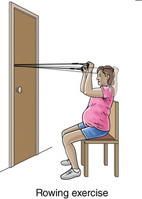
Thoracic extension: While sitting in a chair, clasp both arms behind your head. Gently arch backward and look up toward the ceiling. Repeat 10 times. Do this several times per day.
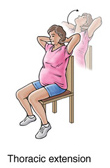
Arm slide on wall: Sit or stand with your back against a wall and your elbows and wrists against the wall. Slowly slide your arms upward as high as you can while keeping your elbows and wrists against the wall. Do 3 sets of 10.
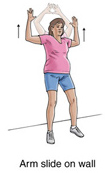
Shoulder abduction: Stand with your arms at your sides with your palms resting against your sides. With your elbows straight, lift your arms out to the side and toward the ceiling. Hold the position for 5 seconds. Do these with a 2 to 4 pound weight in each hand. Repeat 10 times.
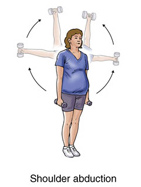
Positions to Avoid During Pregnancy:
Positions that should be avoided during pregnancy depend on what stage of pregnancy you are in. During the fifth month of pregnancy, the uterus is growing rapidly, getting heavier and heavier. Due to the heaviness of the uterus, lying on your back for more that 10 minutes may cause some compression to the blood vessels, which would decrease blood to the uterus and oxygen to the baby.
During the fifth month (or sometimes sooner), it may be uncomfortable to lay on your stomach. So these types of exercises should be avoided. A good rule to follow is do not try any positions that are uncomfortable or do not feel right.
*Adapted from ReleyHealth- Exercise durin pregnancy



Subscribe to our newsletter